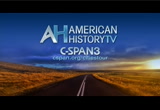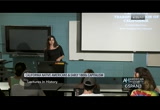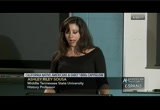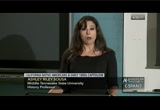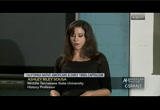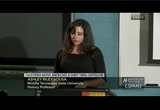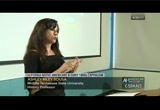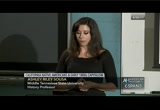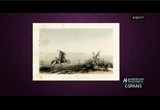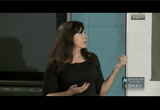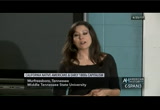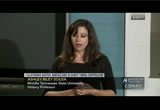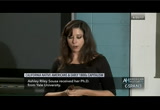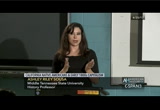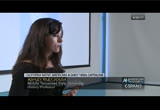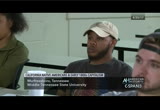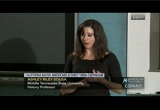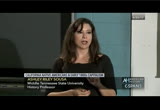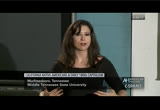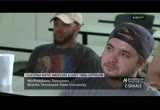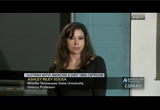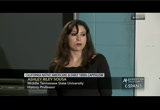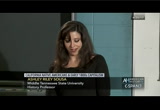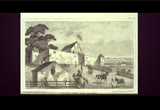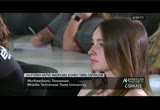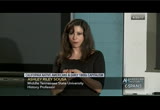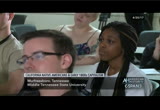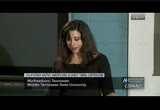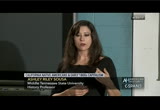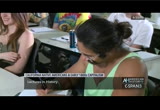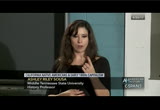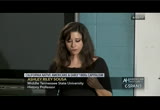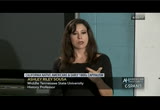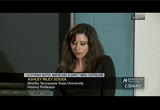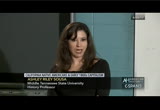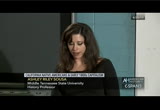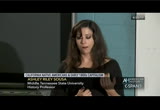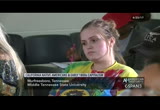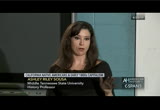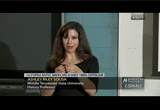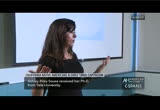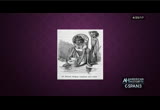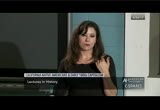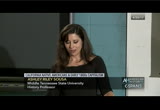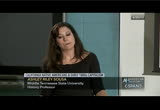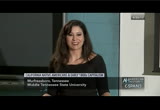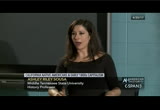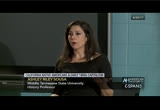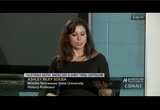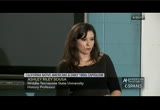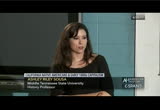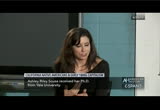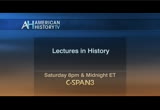tv Lectures in History Ashley Riley Sousa on California Native Americans and... CSPAN October 15, 2017 12:00am-1:17am EDT
12:00 am
people we are all friendly, hey, how are you? that is the nature of a small state and a small capital people all friendly, city. >> thank you so much for taking the time to show us around concord. >> glad to do it. >> you can watch this and other programs on the history of communities across the country \city towards. this is only on c-span3. >> lectures in history. tennessee state professor teaches a class on native americans and capitalism in early 19th-century california.
12:01 am
she teaches with spanish missions and for traders. she talks about the commodities with livestock, for, it and fish. and 15sses about an hour minutes. >> today's lecture is to try to pull together some of the topics with the throughout the semester. we will examine them from a different perspective. indian removal and how it was shaped by the expansion of american democracy as well as the economy.
12:02 am
thean nations like cherokees for example were clearly victimized by the united states government and the state of georgia as well as land-i'm great settlers by the nation's willingness. it illustrates how indians throughout north america continued well beyond the colonialism to make work as much as possible in their favor and with that in mind i want to revisit california today because and help tole] -- build the economy, attract settlers, and transform the territory into an economically viable state during the gold rush. this transformation hinged on catholicof -- missionaries were the vanguard of colonial settlements in california. -- northern frontier in
12:03 am
california in which indians would be converted into spanish subjects loyal to the crown and willing to defend. this meant economic conversion as well as virtual conversion. on one hand doing the lords work trades,rming, skilled so on. on the other hand it required money which was scarce and california. sometimes money could be made in other ways. for example, the backbone of california economy before the gold rush. the most important segment of the workforce in the mission era. richard henry dana was an american sailor aboard the program.
12:04 am
he observed mission santa clara and mission san jose did, in his words, a greater business then any and california. capable and -- i all note, there is more than passing resemblance to glenn danzig. separated at birth? no. one of many contenders [indiscernible] -- begin trading for hidesno. one of, tallow, and wheat.
12:05 am
these commodities were exchanged for manufactured goods. you will remember from our discussion of trade items. the russian for trade company established on california's northern coast for the specific purpose of reducing wheat in alaska, failed to produce enough and the russian american company became a buyer as well. american traders were the most prevalent. especially from the company which dominated trade from the coast to china. coast to china. the pilgrim, not glenn danzig, was -- the hide and tallow
12:06 am
trade was the most important. it another important was livestock. beginning 1830, new mexican visit. partners began to part of what was then called the santa fe trail. historians usually associate the santa fe trail with the connection between missouri and ,f you follow the dotted line the trail also extended onto a lesser extent into california and los angeles. the trade ranged throughout the interior of california. much of the stock was obtained through india. a trading party arrived. again, cloth being central to the trade.
12:07 am
12:08 am
same mission miguel. one complaint the introduction of articles of natives of new mexico has caused extensive robberies. they sell, they trade, they induce indians to steal animals to sell. were tempted to stop the steps by requiring new toican traders to submit inspection before departing california, they tried to elude the authorities and often succeeded. but when they were caught, the extent was astounded. and one raid, california authorities confiscated animals.
12:09 am
in april 18 33 the governor complained the british and americans scavenge on the river, referring to the company on the -- "-- theyartered, identify themselves with the while natives following these same kind of life. from this has come one positive evil. the natives dedicated themselves to the stealing of horses from the missions. the natives in question from the governor's statement were people were people joaquin valley
12:10 am
from the san joaquin valley of california. the speakers of a language -- remember from you earlier, politically dependent but culturally related groups, each saw themselves as separate. -- this is an image down by los angeles. it is a little bit washed out because of the lighting bed if you could see a little closer you would notice there are some
12:11 am
indian men here in the photo that are dressed pretty elegantly, right? especially with the women in the image dressed in sort of like spanish peasant garb. the men are cowboys. mariachidressed like a band. very nicely, right? that kind of shows you the value the missionaries placed on the work they did. that they were allowed to ride horses, basically for a bed net nikole for an indian system. second, there are just pretty nice, right? they are not dressed in the garb of since which the indians presence woulde be. a common technique used in livestock theft was for traders or thieves to approach the
12:12 am
mission in the middle of the night and up the gates of the horse corral. they knew where this was because they themselves once lived there or had friends and families that did or had a good sense of the lay of the land. they would wait patiently, sometimes for hours for horses to wander out of the crawl slowly of their own well. once the herd had left the corolla and ideally wandered a away, they would drive the animal at a full gallop until dawn men that would find a secluded spot to hide out and kind of resting horses a night bit and once the fell would continue to drive however many days it took. the horses tried to pick from the herd, the wrestlers brought them back into line using a sort of ingenious technique firing arrows at the air and horses but they were tied to sticks around the aerial had about an ensure the top said that when they fired the arrows into the horses it would kind of stick them in up to her but not enough to actually do any damage to the
12:13 am
valuable livestock. one of the users of the technique said the horse immediately takes the place in the band and it is unusual to have to punish a horse twice for the same offense. so this is bad enough from the perspective of the missionaries but to make matters worse, it often what hand-in-hand with running away. in june, it was reported that a village in central california harvard some 60 stolen horses mission san juan batista as well as "numerous christian fugitives" from their friends and neighbors. this shows some of the missions. you have san gabriel. on by los angeles. 's closer upista into california closer to san francisco bay. the priest asked for 12 soldiers for the village to retrieve both the versus andy fugitives who
12:14 am
had run away from the mission. livestock was a serious enough problem, the priest therted months later expedition had succeeded in rescuing 49 of 60 roses but the priests were badly quote not a soul was brought back to the mission. 11 considers the skill and courage of the horse thieves it is not surprising the missionaries met with such limited success. i love this image. this is an image taken or recorded in 1856 by some surveyors were involved with surveying the central valley of california for potential railroad tracks, like where might be a good spot to build a railroad. the transcontinental road. this is the interior valley part of california. most notableof the
12:15 am
things about the san joaquin and kings river was the presence of wrestlers.ed indian one of the reasons why i love this image so much is because it happened after the gold rush, right? it indicates to me even after california becomes a state, even after gold-mining becomes its major region for existence, we still see wrestling is a large part of the central valley economy, right? that the trade purses. the only other thing i like about it is in california there is a stereotype that california indians were very docile. very easily defeated. very sort of peaceful and non-combative. california indians do not have same as lakota warrior on horseback, right? -- not as baded
12:16 am
speak. to he does not have they had just but he has some feathers going on, right? he looks like he could do some damage if you tried to get in the way. so i like to say well into the gold rush years the knowledge of central valley is kind of bad. you know, dad. bad. bad. [indiscernible] an english visitor estimated to see 3000 wild horses during two days of travel in the 1840's. centralclaimed in the valley in his words contained a larger portion of wild horses
12:17 am
then any other part of the world. 200-2000.n from enormous herds. in addition to providing a lucrative source of trade also provided a base of subsistence in the interior. an abundant food source. notare probably good and of trading but you can still get along economically by eating them, right? one report in the san joaquin river, indians had become in their words so habituated to iting with horse flesh that was a simple means of substances. so all of a sudden, acorns and corn had been a mainstay of the the 1840's, we see
12:18 am
that at least in the san joaquin valley in the anterior part of california, horse meat becomes a new staple. raiding also went hand-in-hand by one of the many complaints by the hudson bay company. the hazard bay company, that huge for trading company and the rest of the american for trading companies engaged in for trade within california as well as other cities. it is not surprising that upon seeing this they put indians to work at this lucrative pursuit as well. reviewht a river map to an idea of the extent of california's river valley. right? the headwaters, and here is the northernmost extent. it is sort of green.
12:19 am
where this livestock trading, ultimatelyng, and for trading is going to take place. the san joaquin delta region was the finest trapping ground. the population has not quite recovered. triangle off this land right there. in in theacketed sacramento river. thebounded with beaver at time. and a type of october we now call river otter but back then seat was distinguished from otter. are you guys familiar with
12:20 am
california sea otters? like one something million hairs per square inch. worth a lot, right? so going after beaver and land at her as they were -- land otters was not as hot as sea otter but when sea populations began to diminish, they turned to california beavers and land auditors. -- in land otters. the people of the san joaquin delta headnote technology for fear -- the people of the san joaquin delta had no technology
12:21 am
for trapping. you are talking about a changing temperature. like, it is freezing. i am burning hot in the summer. you do narrow window, not have the need for a lot of clothing, right? so largely ready naked because you did not have to bundle up. there is no need to hunt beaver. they have no native technology.
12:22 am
sometimes they look at beaver occasionally for food. nothing for turning for into clothing. certainly by the 1820's under the authority of the spanish mission, they do so for the sole purpose of obtaining trade goods. that is her only reason, right? they would not have done it otherwise. the spanish missionaries really did not appreciate. they were not above trade goods to indians to get them. usy said, they are ripping off. steal livestock and it is an outrage to the indians.
12:23 am
so they are sort of, you know, not really properly walking the walk. the hudson bay company as well got in on this action. 1828-1843, the chief california brigade leader 1828ted to his boss and "beaver has become an article of traffic on the coast. towards a 1500 beaver skin sold to ships. with new mexican traders. backare going to ring is something and then we trade cash which in the remote frontier area would've been a boon to any trader. he affirms the source of these scans was a party of indian trappers in the delta explaining
12:24 am
the people, while trapping influence of the ocean -- meaning where the types of up -- the indians collect a few scans each which they murder for red and white beads and wearing up how their code sailed a shiptain the river and noted the indian scans had been so successful with a little help from the drop which of course happens pretty regularly and california to leave the tributaries nearly devoid of beaver and otter. those so remained were in his words refuse. the captain and countered mission indians below the river where they hadto literally written they had
12:25 am
permission to do trapping. they were given passes specifically allowing them to leave mission san jose and the influence of the christian missionaries and spanish civilization. right? indians who had never been in me mission? so think about the perspective. right? like, that is how valuable for trapping would have been. course their relatives, friends, neighbors, fellow tribes people. right? these are there crew. so as they sort of left with these passes they went home to sort of engage in this trade throughout the 1820's and 1830's. trappers in sacramento's san joaquin delta were incredibly good at their work and very protective of their trapping ground.
12:26 am
un-american trapdoor into guys might recognize this name because he is sort of in the lexicon. we know. not to be confused with debit i.s. springfield, founder of springfield. different guy. hostile reception his trapping party received from indians 1828.the river in so it suggests to me these indian people immediately identified the party as an economic threat and understood the competition in one of resented to the trapping effort. smith interpreted the reluctance as evidence of fear of strangers. the indians were not so timid scared of the white men there
12:27 am
were willing to sit by and allow debit i.s. party to trap -- and party to smith's trap. they realized other traps had been taken by the indians. they reported a good many had been taken by the indians who showed themselves on the opposite side of the river. like, what are you going to do about it, right? an unfortunate episode of poaching, right? because these are our neighbors. it turned into an economic opportunity, right? they stole the traps in the beavers. that is just good business. the business. a little threat.
12:28 am
metal course, expensive traps which as you know the native people did not work earned or steel themselves. so making off with the steel traps would've been in economic advantage. alexandering year, macleod, the chief leader of the california brigade noted along the river, indians were still trapping. so again, trapping, right? steal their traps and sell their horses. he reported that deserters from the party from the year before try to stick around central valley and stay behind and do more trapping after their disastrous encounter with the indians on the river and ended up getting killed by the indians, right question mark the indians were like, you cannot poach on our territory.
12:29 am
these are not people who do not understand the motivation of these people. in 1833, indians and the river, and these guys were like apparently the guys to be afraid of because they were not messing around at all, noticed they seemed to steal the traps for the beaver in them. so they had a moment where they were like, they want the beaver because the beaver your are valuable. the economic importance of indian trapping which is especially notable did notat the indians enter into 1834, right.
12:30 am
right? as soon as they see an economic opportunity, they are seizing it. were probably -- when white settlers began arriving, they became yet another market for indian firm. , johnly the most famous sutter, the proprietor of a colony often offered trade goods exchange trappers in for beaver, otter, and other for-bearing skins. this is probably his most flattering portrait. we need to bring back that -- what is that called?
12:31 am
that fashion? the ascot. a good look. he put himself in direct competition with mission san jose and with a growing number indianlers as a buyer of her. by the fall of 1841, 2 years after he founded his colony, sector claimed -- anti-is kind of a notorious liar so i will -- claim, to be selling some his trapping crew was 20 guys, right? if you can imagine 20 guys doing , indiand of damage marketplace his own
12:32 am
-- on the most desirable trade goods. currency. california indian economy. was situated on the sacramento river and the northern part of the river where indian middlemen took first from trappers. was situated on the some of them technically such errors employees. marketing them to whoever could supply the best goods. these guys were like a ok. we'll take your pain and sell our firm to someone who will --
12:33 am
and sell the fur to someone who will pay us better. all kind of tasks ranging from for trapping to tending to weaving cloth, harvesting wheat, you name it. they were building a particular kind of brick called adobe. northern mexico, what we would now call the southwest. ae entire place was sort of monument to the willingness of indians to engage in economic activity. i don't want to overstate my
12:34 am
case. there were some who were less willing. described as being enslaved. the actual property being worked. it is not clear. this tended something to be that did not need a lot of coercion to get indian to participate in. the most trading with indians were the same as almost everywhere else in california.
12:35 am
cloth beads. especially cotton tellico. knives, axes, fishhooks, needles, threads, flour. having about commodities elastic demand, right? there is a limited amount of axes but everyone needs more clothing, right? beadsu always want more because everybody wants more cash, right? this is what they demanded in the economy. these goods seemed because they were like manufactured cloth or glass or bone, they seem like a novel. way theyse them in a did not have to reinvent the
12:36 am
12:37 am
societies,-gatherer women were the primary gatherers. >> think about the communities that would have been best the convenience that would have been represented by not having to make your own fabric, not having to put your own birds. manufactured cloth is an important timesaver that would have had an immediate and noticeable positive effect on a person's daily and weekly schedule. wild duck feathers were an important source of clothing and blankets. "the labor of making one of these blankets is immense. center presented
12:38 am
me with one pickup -- with one." you are saving a lot of time. i'm going to say wool instead of calico in this case. it is probably the warmer option. whatever it may become your -- whatever it may be, you are setting yourself a tremendous amount of time. men also debated in cloth manufacturing, weaving feathers and rabbit skins into cloaks and atnkets, which closed village -- which clothed villagers of both sexes. at village -- whichaccess to manufd able men to enjoy enhanced status and prestige, and women to enjoy enhanced status and prestige that the rise from the
12:39 am
very real economic responsibility of clothing your family and community members. this is what makes me a man or a woman. it is important in indian societies as it is around the world. the idea you are filling your duty as a man or woman was very tight into economic activity. you can see that not only is there a real economic benefit to -- there is also reaffirmation of your culture. it makes you more economically important in your community. that madeing the guy beads. they are valuable because they are currency. they operate as cash in transaction between different california indian societies. it is also necessary to have a few beads, and by a few i mean a
12:40 am
lot, in order to pay the bride prize for marriage. you guys are familiar with ideas like dowries that you're taking your future wife out of her parents household, and there is now going to be less work happening in the household, so you have to not pay for her, but have to sort of reimburse their parents for losing the value of her labor. we talked about this, the only reason to have children is to have free labor. i still haven't figured that out. you've got to have some beads on hand because if i am losing my productivityonomic , i am going to want something really good for it. the best thing you can get his cash. everybody wants to be paid in cash. valley california indian
12:41 am
people favored a certain type of bead made from a clamshell that can only be obtained along the northern california coast north of san francisco, and so these disc shaped clamshell beads became the fundamental unit of currency in california in indian economy. beginning in the mission era and into the gold rush era, european and american traders introduced manufactured glass beads imported from europe. you go from having one color, into the gold rushwhite, and that you can onlt if you trade really well with these indians and northern san francisco, and all of a sudden every white person will pay you in beads which cost nothing to the white folks bringing the , but into the transaction who, for indians, it would be like someone saying they will pay you in bags of $100 bills, which in california, and this remote front area, is like money falling from heaven.
12:42 am
the richards initially in california by the hudson's bay offany who conducted trade of ships and san francisco bay. in beads become ubiquitous california indian communities, especially in the delta region among these communities on before they ever did business with john sutter. they lived alongside white people, they were reaching out and seeking opportunities to get paid in these beads. red and white beads were the colors most often demanded by indian consumers. white functioned as currency and read it seems most likely to have been used as a ceremonial adornment during religious ceremonies. the ability to earn beads for work at a place like new healthy elvetia wouldw h have been viable.
12:43 am
68 Views
IN COLLECTIONS
CSPAN3 Television Archive
Television Archive  Television Archive News Search Service
Television Archive News Search Service 
Uploaded by TV Archive on

 Live Music Archive
Live Music Archive Librivox Free Audio
Librivox Free Audio Metropolitan Museum
Metropolitan Museum Cleveland Museum of Art
Cleveland Museum of Art Internet Arcade
Internet Arcade Console Living Room
Console Living Room Books to Borrow
Books to Borrow Open Library
Open Library TV News
TV News Understanding 9/11
Understanding 9/11